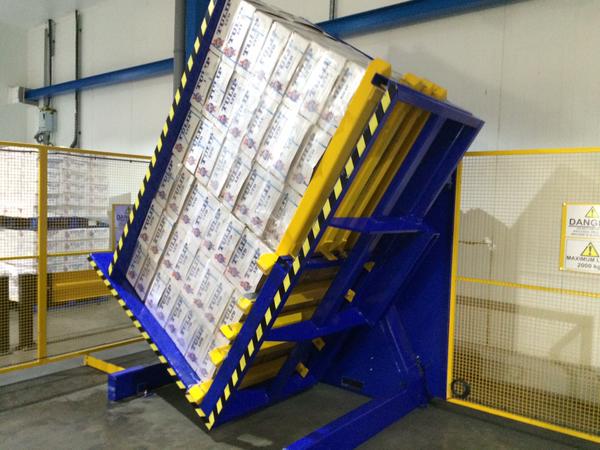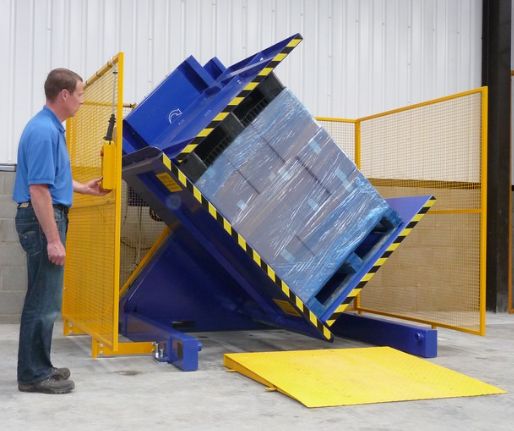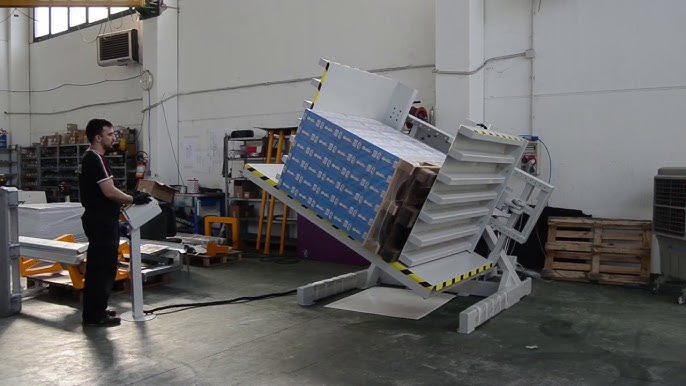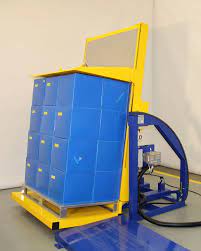Pallet Changing Machine: How to Ensure Safety When Swapping Equipment Pallets?
When you're running a high-capacity facility like a steel mill, every part of your operation matters. You handle heavy, valuable products day in and day out. An accident, especially in a seemingly simple task like swapping a pallet, can have huge consequences. It can lead to damaged goods, costly downtime, and, most importantly, injured team members. I've seen firsthand how a single failure in the packaging line can bring a multi-million dollar operation to a halt. This risk is something leaders like you have to manage every day.
To ensure safety when swapping equipment pallets, you must implement a four-part strategy. First, select a pallet changing machine with essential, built-in safety features like physical guarding and emergency systems. Second, develop and enforce clear Standard Operating Procedures (SOPs). Third, provide comprehensive, hands-on training for all operators. Finally, commit to a rigorous schedule of preventative maintenance and regular inspections.

This four-part approach creates multiple layers of protection. It moves safety from being an afterthought to being a core part of your process. It’s not just about buying a machine; it's about building a complete safety system around it. For a pragmatic leader who analyzes every investment for ROI and stability, this systematic approach is the only way to guarantee a safe and efficient operation. Let’s break down each of these essential components so you can see how they work together.
What Are the Core Safety Features a Pallet Changing Machine Must Have?
You're looking to invest in a new piece of equipment. You see datasheets with lots of features, but how do you know which ones actually keep your people safe? Choosing a machine based on price or speed alone is a dangerous gamble. A pallet changer without the right, non-negotiable safety features is a liability waiting to happen in your facility. For an operation handling heavy steel products, a machine failure isn't a small problem—it can be a catastrophic event. Relying only on an operator's skill to prevent an accident is not a sustainable or safe strategy. True safety is engineered into the machine from the ground up. It anticipates potential failures and protects your team and your product automatically.
A truly safe pallet changing machine must have robust physical guarding, such as high-tensile safety fencing and light curtains, to create a secure operating zone. It also requires multiple, easily accessible emergency stop buttons, an intelligent control system with safety-rated logic, and an automated clamping system that senses and adjusts to the load to prevent it from shifting or dropping during the transfer cycle.

These features are not optional extras; they are the fundamental building blocks of a safe machine. When I started my own factory, SHJLPACK, my first principle was that safety could never be compromised for cost. This belief comes from my years on the factory floor, where I saw what happens when equipment isn't designed with the operator in mind. Let’s look closer at these critical features.
Physical Guarding: Your First Line of Defense
Physical guards are the most visible safety feature, and for good reason. They create a clear and solid barrier between your personnel and the machine's moving parts.
- Perimeter Fencing: This should be high-strength fencing that completely encloses the machine's operational area. It's not just a visual warning; it's a physical barrier that prevents anyone from accidentally walking into the machine's path. The gates should have interlocking switches, meaning the machine cannot start or will immediately stop if a gate is opened. This is a simple but incredibly effective safety measure.
- Light Curtains: These are advanced safety devices that create an invisible infrared beam across access points, like the area where a forklift loads a pallet. If an operator's hand, arm, or body breaks this beam while the machine is in a dangerous part of its cycle, it sends an immediate stop signal to the control system. This provides protection without needing a physical gate, which can improve workflow efficiency.
Control Systems and Emergency Measures
The machine's "brain" must be programmed for safety. A reliable control system is the difference between a controlled stop and a dangerous failure.
- Emergency Stop (E-Stop) Buttons: These must be prominent, easy to reach from all sides of the machine, and foolproof. When an E-stop is pressed, it should override all other commands and bring the machine to the safest possible stop immediately.
- Safety PLC (Programmable Logic Controller): Modern machines use a dedicated safety PLC. Unlike a standard PLC that just runs the operation, a safety PLC constantly monitors all safety inputs—like E-stops, gate switches, and light curtains. It's designed with redundant circuits to be fail-safe, meaning if a component fails, the system defaults to a safe state.
Load Handling and Stability
For a steel mill handling heavy, and sometimes unevenly balanced, loads, how the machine holds the product is critical.
- Automated Clamping Pressure: The machine must securely clamp the load before it begins to tilt or transfer it. The best systems use sensors to detect the height of the load and apply the appropriate clamping pressure. Too little pressure, and the load can shift. Too much, and you can damage the product. This intelligent clamping is crucial for preventing dropped loads.
- Overload Protection: The machine must have sensors to detect if a load exceeds its maximum rated capacity. If an overloaded pallet is placed on the machine, the system should refuse to operate and display a warning. This prevents catastrophic mechanical failure from stressing the machine beyond its design limits.
| Safety Feature | Function | Why it's Critical for a Heavy-Duty Environment |
|---|---|---|
| Interlocking Gates | Prevent the machine from running when a gate in the fence is open. | Guarantees no one can enter the operating zone during a cycle. |
| Light Curtains | Create an invisible safety barrier that stops the machine if crossed. | Protects operators during loading/unloading without a physical gate. |
| Intelligent Clamping | Automatically adjusts clamping force based on load height and type. | Prevents product damage and ensures heavy loads are held securely. |
| Overload Sensors | Detect when a load's weight exceeds the machine's rated capacity. | Stops mechanical failure and accidents caused by overloading. |
| Safety PLC | A dedicated, fail-safe controller that monitors all safety devices. | Provides a highly reliable foundation for the entire safety system. |
How Do You Develop Safe Operating Procedures (SOPs) for Pallet Swapping?
You can invest in the safest, most advanced pallet changing machine on the market. But if you don't define how your team should use it, you're leaving safety up to chance. Without clear, standardized rules, operators will develop their own habits. This inconsistency is a direct threat to safety and efficiency. I've walked into factories where the day shift and the night shift operate the same machine in completely different ways. This creates confusion, increases the risk of mistakes, and makes it impossible to trace the root cause of a problem. For a leader responsible for overall plant performance, this lack of standardization is unacceptable. It undermines your investment in good equipment and opens the door to accidents. The solution is to create and enforce clear, simple, and detailed Safe Operating Procedures (SOPs).
To develop effective SOPs for a pallet changing machine, you must first perform a thorough risk assessment of the entire process. Then, document each step in a clear, easy-to-understand format, covering pre-operation checks, loading, machine operation, and unloading. Finally, these procedures must be officially approved, clearly communicated to all staff, and reviewed on a regular basis to ensure they remain relevant and effective.

An SOP is more than just a document; it's a formal agreement on the single, safest, and most efficient way to perform a task. It is the foundation of a disciplined and professional operation. Let's walk through how to build one.
The Foundation: Risk Assessment
Before you write a single instruction, you must understand the risks. This is a practical, not a theoretical, exercise. Gather the team—the operators who will use the machine, a maintenance technician, and a safety manager. Walk through the entire pallet swapping process step-by-step. For each step, ask:
- What could go wrong here? (Identify the hazard)
- How likely is it to happen and how severe would it be? (Assess the risk)
- What can we do to prevent it? (Determine the control measure)
This simple process will form the backbone of your SOP. For example, a hazard might be "placing an unstable load on the machine." The risk is a "dropped load during rotation, causing product damage and potential injury." The control measure is "the operator must visually inspect every load for stability before loading." This control measure now becomes a required step in your SOP.
Writing the SOP: Clarity is Key
An SOP is useless if it's confusing or hard to read. Use simple language, short sentences, and a clear, logical flow. Avoid technical jargon whenever possible. I always recommend including photos or simple diagrams for key steps. A good SOP should be structured in distinct sections.
- Purpose: What is this procedure for? (e.g., "To safely transfer steel coils from a wooden pallet to a plastic pallet.")
- Scope: Who does this apply to? (e.g., "All trained operators in the packaging department.")
- Responsibilities: Who is responsible for what? (e.g., "The Operator is responsible for following the procedure. The Supervisor is responsible for ensuring compliance.")
- Procedure: This is the core of the document. Break it down into numbered steps:
- Pre-Operation Checks (e.g., "Verify safety guards are in place.")
- Loading the Machine (e.g., "Center the pallet within the designated markings.")
- Operating the Machine (e.g., "Press the green 'Start Cycle' button.")
- Unloading the Machine (e.g., "Wait for the green light before removing the pallet.")
- Emergency Procedures: What to do if something goes wrong.
Implementation and Review
An SOP sitting on a shelf does nothing. It must be a living document.
- Training: Use the SOP as your primary training document.
- Accessibility: Post a laminated copy of the SOP at the machine itself.
- Review: Schedule a formal review of the SOP at least once a year, or anytime there is a near-miss, an accident, or a change in the process or equipment. This commitment to continuous improvement is what separates good companies from great ones.
| SOP Section | Key Elements to Include | Rationale for a High-Stakes Environment |
|---|---|---|
| 1. Risk Assessment | A documented analysis of hazards and control measures. | Proactively identifies and mitigates risks before they cause an incident. |
| 2. Clear Instructions | Simple, step-by-step actions with visuals. | Eliminates guesswork and ensures every operator performs the task identically. |
| 3. Emergency Plan | Specific steps for what to do in case of machine malfunction or other emergency. | Prepares operators to react calmly and correctly, minimizing damage. |
| 4. Regular Review | A scheduled process for updating the SOP based on feedback and incidents. | Ensures the procedure evolves and remains effective over time. |
What Role Does Operator Training Play in Pallet Changer Safety?
You have the best machine with top-tier safety features. You have a detailed, crystal-clear SOP. But what about the human element? An operator who is not properly trained can defeat even the most advanced safety system. They might not understand the risks, they might take shortcuts, or they might simply not know how to react in an emergency. From my early days as an engineer, I learned a hard lesson: never underestimate the importance of training. I saw a brand-new, expensive machine get severely damaged in its first week of operation simply because the operator wasn't trained on its capacity limits. For a leader focused on maximizing uptime and protecting your investment, a preventable incident like that is a major failure. It's not just about the cost of repair; it's about the lost production and the erosion of your safety culture.
Operator training plays the most critical role in pallet changer safety because it bridges the gap between the equipment and the procedure. Its purpose is to ensure every operator not only understands how to run the machine but also comprehends the "why" behind the safety rules. Effective training must combine theoretical knowledge of the SOPs and safety features with extensive, supervised, hands-on practice and a formal competency assessment.

Think of it this way: the machine provides the potential for safety, the SOP provides the instructions, but only training creates the competence. It transforms your safety program from a set of rules on paper into a practical skill set that your team uses every single day.
What Comprehensive Training Must Cover
Effective training goes far beyond just showing someone which buttons to push. It must build a deep understanding and a professional respect for the machinery.
- Theory and Hazard Awareness: This classroom-style session should use the SOP as its guide. You must explain what each safety feature does and, more importantly, why it is there. Explain the specific risks associated with the machine—pinch points, crush zones, and the dangers of an unstable load. When an operator understands the potential consequences, they are far more likely to follow the rules.
- Hands-On Operation: Theory is not enough. The operator must get their hands on the machine under the close supervision of an experienced trainer. Start with no load, then move to dummy loads, and finally to actual products. They should practice the full operating cycle multiple times until their actions are smooth, confident, and exactly match the SOP.
- Emergency Response Drills: What does the operator do if the power fails mid-cycle? What if a load gets jammed? You need to simulate these scenarios in a controlled way. Practice using the E-stop. Practice the shutdown and lockout/tagout procedure. A confident and correct response in the first few seconds of an emergency can prevent a minor issue from becoming a major disaster.
A Continuous Training Approach
Training is not a one-time event. You need a structured program.
- New Hire Training: Every new operator must go through the full training program and be certified as competent before they are allowed to operate the machine alone.
- Refresher Training: At least once a year, all certified operators should undergo refresher training. This reinforces good habits and provides an opportunity to discuss any near-misses or new challenges.
- Post-Incident Training: If an accident or near-miss occurs, retraining for all involved operators should be an automatic part of the corrective action plan.
Proving Competence
How do you know the training was successful? You need to assess it. A simple written quiz can check theoretical knowledge, but the real test is practical. The trainer or supervisor must observe the operator performing the task and sign off on a checklist confirming that they can execute every step of the SOP safely and efficiently. This signed document becomes part of the operator's training record, providing clear evidence of their competence.
| Training Module | Content Focus | Desired Outcome |
|---|---|---|
| Theory & Safety | Machine mechanics, safety features (what they are, why they exist), SOP review. | Operator understands the risks and the purpose of safety protocols. |
| Practical Operation | Supervised, hands-on use with dummy loads, then real loads. | Operator can perform the entire pallet swapping cycle safely and efficiently. |
| Emergency Drills | Simulating common failures: power loss, jammed load, E-stop activation. | Operator can react correctly and calmly in an emergency, minimizing risk and damage. |
| Competency Check | A formal, observed assessment of the operator's ability to follow the SOP. | Provides documented proof that the operator is qualified to run the machine. |
How Can Maintenance and Regular Inspections Prevent Pallet Changer Accidents?
Your pallet changing machine is a workhorse. It operates cycle after cycle, handling heavy loads in a demanding industrial environment. Over time, even the best-built machine is subject to wear and tear. A hydraulic hose can weaken, a sensor can drift out of calibration, or a structural bolt can loosen. These problems often develop silently, with no obvious signs, until they lead to a sudden and dangerous failure. You know this challenge well from managing aging equipment across your plant. A reactive approach—waiting for something to break before you fix it—is incredibly risky and expensive. A breakdown not only creates a safety hazard but can also halt your entire packaging line, causing production delays that ripple through your entire schedule. This directly contradicts your goal of increasing uptime and reducing costs.
Regular maintenance and a structured inspection program are the keys to preventing accidents and unplanned downtime. This proactive strategy ensures that all mechanical components and, critically, all safety features of the pallet changer are kept in optimal working condition. By scheduling a combination of daily operator checks, weekly technical inspections, and periodic professional servicing, you can identify and correct potential failures like hydraulic leaks, sensor malfunctions, or metal fatigue before they escalate into a dangerous accident.

This is the essence of predictive maintenance, a philosophy that is crucial for any modern, efficient operation. It's about shifting from a "fail and fix" mindset to a "predict and prevent" one. It saves money, improves reliability, and, most importantly, keeps your people safe.
Building Your Proactive Maintenance Schedule
A robust maintenance plan has multiple layers. Each layer has a different frequency and level of detail, creating a comprehensive safety net.
- Daily Operator Checks (Pre-Start): The operator is your first line of defense. Before their shift, they should perform a quick visual inspection. This takes less than two minutes. They should look for obvious issues: Are the guards in place? Is the area around the machine clear? Are there any visible fluid leaks? This simple habit empowers the operator and can catch many problems at the earliest stage.
- Weekly In-House Inspections: Once a week, a trained maintenance technician should perform a more detailed check. This involves functionally testing the safety systems. Press every E-stop button. Intentionally break the light curtain beam. Open the safety gates. Does the machine stop as it should? They should also check fluid levels and look for signs of wear on chains or belts.
- Annual Professional Service: Once a year, it's a wise investment to have the machine serviced by an expert, either from our team at SHJLPACK or another qualified specialist. They can perform tasks like calibrating sensors, pressure-testing hydraulic systems, and inspecting the machine's core structure for any signs of fatigue. This expert assessment ensures the long-term health and safety of your equipment.
The Power of Documentation
Every check, every repair, and every observation must be recorded in a dedicated maintenance logbook for that machine. This documentation is vital for several reasons.
- Accountability: It ensures that the scheduled checks are actually being done.
- Compliance: During a safety audit, this logbook is your proof that you are maintaining your equipment properly.
- Data Analysis: Over time, this logbook becomes a valuable source of data. If you see the same minor fault being reported every few weeks, it points to a deeper, underlying problem that needs to be addressed. This data is the foundation of a true predictive maintenance program and helps you make smarter decisions about future equipment purchases.
| Inspection Frequency | Performed By | Key Checks | Rationale for Predictive Maintenance |
|---|---|---|---|
| Daily | Operator | Visual check of guards, E-stops, work area cleanliness, any obvious leaks or damage. | Catches immediate, visible hazards. Instills operator ownership. |
| Weekly | Maintenance Technician | Functionally test all safety circuits (E-stops, light curtains), check fluid levels. | Verifies that critical safety systems are working as designed. |
| Monthly | Maintenance Technician | Lubricate moving parts, check for loose fasteners, inspect electrical connections. | Prevents accelerated wear and tear and ensures mechanical integrity. |
| Annually | OEM Specialist | In-depth inspection, system calibration, pressure testing, software updates. | Provides expert assessment and ensures long-term reliability and compliance. |
My Insights: A Pallet Changer is More Than a Machine; It's a Safety System
I remember consulting for a steel wire company in Mexico. Their operation was impressive—large, modern, and focused on output. But their packaging area felt like a different world. To swap pallets for their heavy coils of steel wire, they were using a risky method with two forklifts. One would lift the coil slightly while the other tried to pull the old pallet out and slide a new one in. It was a tense, dangerous process. They had near-misses almost weekly.
I sat down with the plant owner, a man very much like Javier—sharp, experienced, and focused on the bottom line. He saw a proper pallet changing machine as a significant, and perhaps unnecessary, expense. He asked me for the ROI.
So, we didn't start by talking about the machine's price. We started by calculating the cost of their current method. We calculated the real cost of one dropped coil—not just the thousands of dollars in scrapped material, but the hours of downtime for the entire line, the risk of a severe injury, and the potential for a delayed shipment to a key customer. We calculated the wasted man-hours of two forklift operators and a spotter tied up in a single, slow task. The numbers were shocking, even to him.
When they finally invested in a robust pallet inverter designed for their specific needs, the payback period wasn't measured in years or months. It was measured in weeks. But the real ROI came a few months later. The owner told me that the biggest change was on the factory floor. His team felt safer. They felt the company was investing in their well-being. That change in morale, he said, was priceless.
For a leader who understands that your people and your processes are what truly drive profit and stability, this is the key insight. Don't look at a pallet changer as just another machine or a cost center. View it as a fundamental investment in the safety, efficiency, and stability of your entire operation. It's a system that protects your most valuable assets: your people and your product.
Conclusion
Investing in a safe pallet changing machine and process is non-negotiable. It protects your people, your product, and your bottom line, ensuring operational stability and long-term success.



